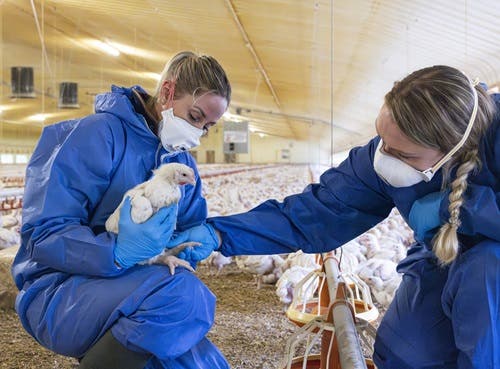What is hock burn in poultry?
Hock burn is a common welfare issue affecting broiler chickens. It is characterised by dark, discoloured patches on the joint of a bird's leg – the hock.
These lesions generally indicate underlying management challenges that can affect bird health, welfare, and production performance.
In this article, we explore the causes of hock burn, its impact on poultry production and effective strategies to help prevent it.
What causes hock burn in poultry?
Hock burn occurs when the sensitive skin on the bird’s hocks becomes inflamed or damaged, often due to prolonged contact with wet, soiled litter.
High ammonia levels from manure exacerbate the condition, causing chemical burns.
Factors which can contribute to this include:
- Compromised Intestinal Integrity
Diseases such as poultry coccidiosis and necrotic enteritis can compromise intestinal health and lead to loose droppings and wet litter. This creates an optimal environment for hock burn to occur. Therefore, preventing these intestinal diseases is crucial for reducing the risk of hock burn. - Footpad dermatitis
Hock burn is often seen alongside footpad dermatitis, another welfare issue caused by similar environmental factors. Both conditions are indicators of damp litter and can impact on bird health. - Poultry heat stress
Challenges with ventilation and temperature management within sheds can contribute to hock burn in poultry.

The impact of hock burn on poultry production
Hock burn, among other welfare issues, can increase bird stress, which may compromise their Intestinal Integrity. Reduced Intestinal Integrity could contribute to poultry coccidiosis challenges, further impacting bird health and overall performance.
But hock burn is more than a welfare issue – it can negatively affect farm profitability. Severe cases are often linked to poor broiler feed conversion ratios (FCR), as birds experiencing the effect of the disease may eat less and grow more slowly.
In this instance, tools like an FCR calculator can help monitor feed efficiency and identify areas for improvement. Maintaining good broiler feed conversion ratios not only reduces production costs, but also ensures healthy, thriving birds.
Birds with hock burn are more likely to be downgraded, resulting in reduced profitability.
How to prevent hock burn
1. Manage the birds’ environment
Keep litter dry by optimising ventilation, fixing water spillage issues, and ensuring suitable drainage. High temperatures and humidity, which contribute to poultry heat stress, should also be managed through effective climate control.
2. Promote Intestinal Integrity
Preventing diseases like poultry coccidiosis and necrotic enteritis, which cause loose droppings, is essential for keeping litter conditions dry. Using Maxiban™ in combination with Monteban™ provides a stable coccidial population control, promoting flock performance, and therefore reducing the likelihood of wet litter that leads to hock burn.
3. Benchmark broiler flock health Elanco’s Health Tracking System (HTSi) supports producers in preventing hock burn by providing data-driven insights and benchmarking to monitor flock health and identify contributing factors, such as poor litter quality and inadequate ventilation.
By analysing patterns and offering expert guidance, HTSi enables targeted interventions to improve management practices and enhance bird welfare, ensuring healthier flocks and better production outcomes.
Hock burn in poultry is an avoidable issue when farm management practices prioritise bird welfare and environmental conditions. By addressing key factors like litter quality, intestinal health, and production benchmarking, producers can improve overall bird health and production metrics.
Elanco UK AH Limited, Form 2, Bartley Way, Bartley Wood Business Park, Hook RG27 9XA. Telephone: 01256 353131. Email: elancouk@elanco.com
Maxiban, Monteban, HTSi, Elanco and the diagonal bar logo are trademarks of Elanco or its affiliates. © 2025 Elanco or its affiliates. Date of preparation: 11/2024